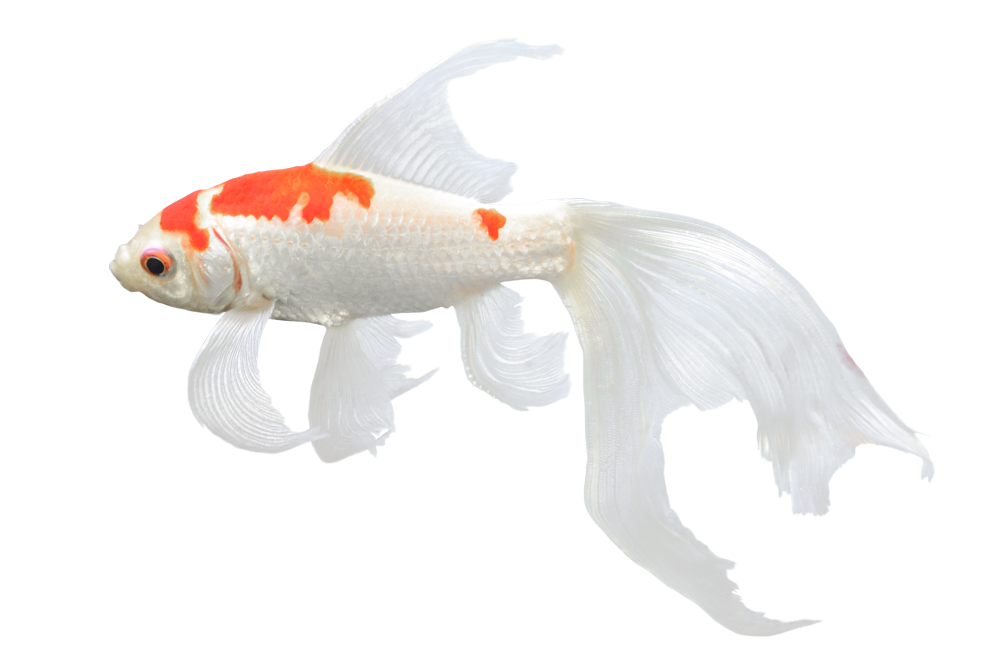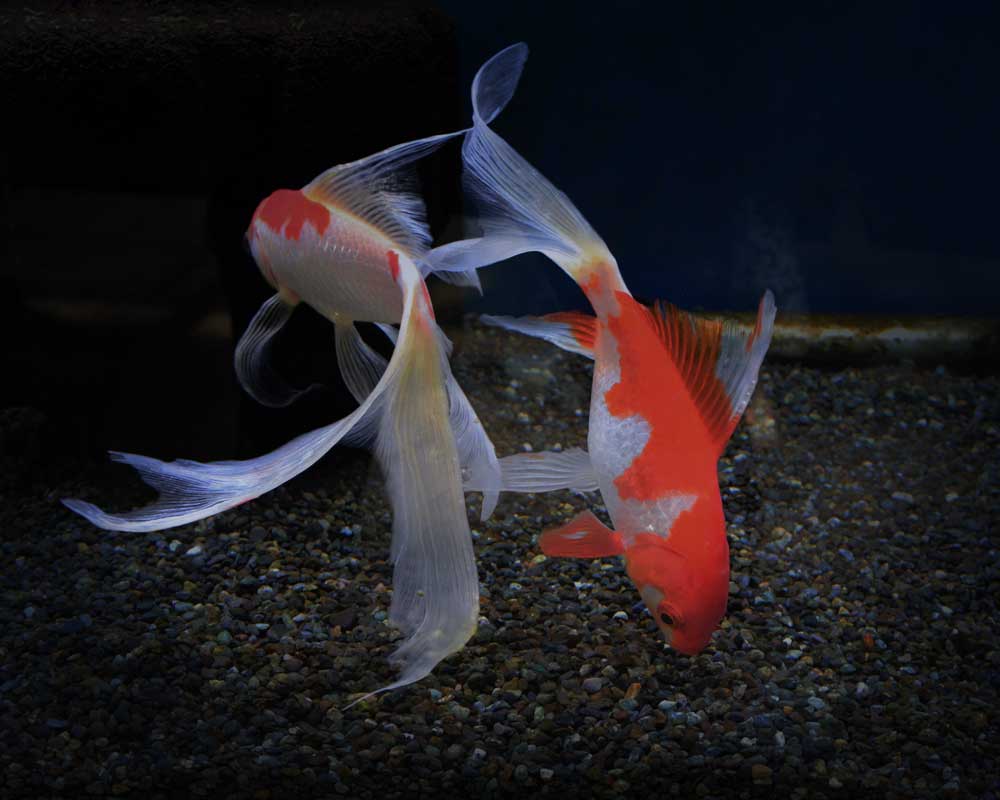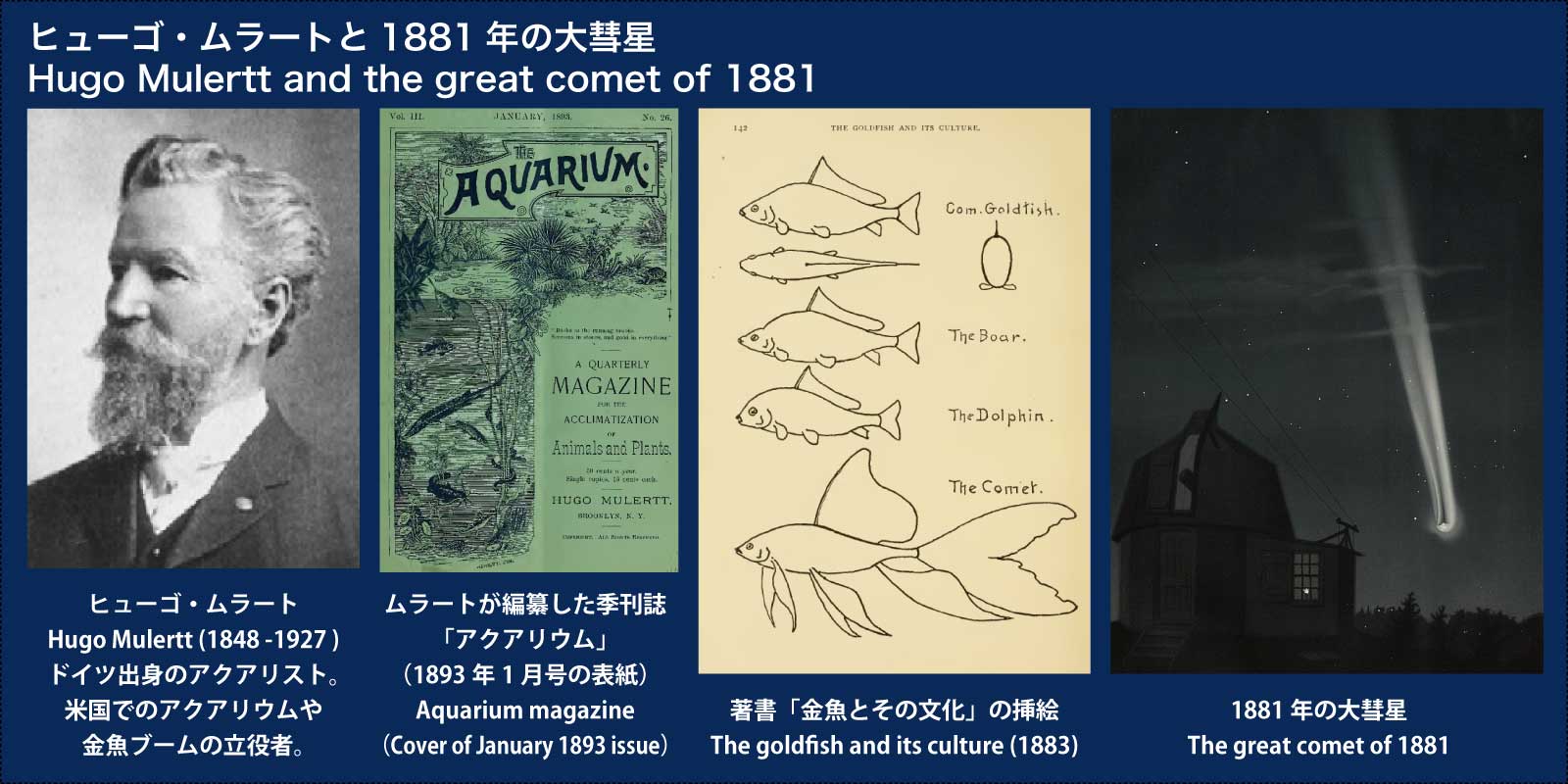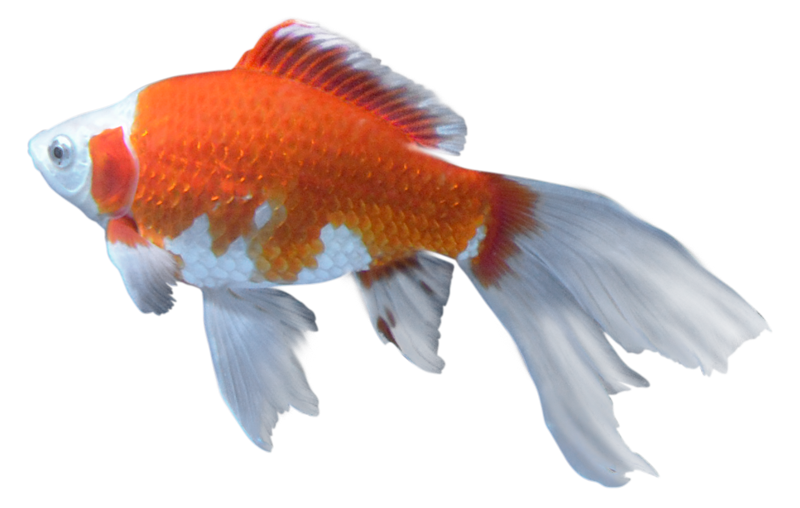
Carassius auratus var. 14
1881年夏の出来事
Events of the summer of 1881
コメットは19世紀末に米国で生まれた金魚です。日本から輸出された琉金の中から、アメリカワシントン水産委員会の池で発見された琉金の突然変異個体を、ヒューゴ・ムラート(Hugo Mulertt)がそれをフナと交雑させ、選別・淘汰して固定したのが始まりです。ムラートはドイツ出身で米国に移住したアクアリストで盆栽家としても知られています。
コメットはその後日本に逆輸入され広く普及しました。V字に長く伸びたフキナガシ尾が特徴で、体色は黄色、オレンジ、赤、白、更紗(赤白)と明るい色味です。朱文金と似ていますが黒い模様は入りません。更紗が基本色ですが、最近は黄色のレモンコメットが人気です。大きくてスマートな体で泳ぎが早く、寿命は10 – 15年と、他の金魚に比べて丈夫で長生きします。成長すると体長は25 – 30cmにもなることもあります。動きが素早いので、他の金魚と同じ水槽に入れるとエサを独占してしまいます。
さて、ヒューゴ・ムラートがこの新しい品種を発見したのは1881年の夏のことでした。「大草原の小さな家」の作者ローラ・インガルス・ワイルダーは自伝「パイオニア・ガール」で、その当時の大きな出来事として空に大きな彗星が現れたと書き記しています。彗星(C/1881 K1)は当時シンシナティにいたムラートも目撃し、この金魚が彗星のような長い尾を持つのでComet(彗星)という名前を名付けました。
ムラートはシンシナティで金魚養殖場を営んでいましましたが、1884年のオハイオ川の洪水が彼の数千匹ものあらゆる種類の魚を流し去ってしまいました。珍しい魚も含まれたといいます。その後ムラートは金魚養殖場を再興したのかわかりませんが、季刊誌「アクアリウム」を発行し、アクリウムブームの立役者となりました。シンシナティはオハイオ川の栄養豊かな水質が養魚に最適で、1970 年代まで米国最大の金魚生産地の一つでした。
The Comet is a goldfish that originated in the United States at the end of the 19th century. It originated when Hugo Mulertt discovered a mutant Ryukin goldfish in a pond owned by the Washington Fisheries Commission among those exported from Japan. He crossbred it with a crucian carp, selecting and culling it to stabilize it. He was originally from Germany and immigrated to the United States as an aquarist and bonsai artist.
The Comet was later re-imported to Japan and became widely popular. It features a long, V-shaped, butterbur-like tail and bright body colors, including yellow, orange, red, white, and chintz (red and white). It resembles the Shubunkin goldfish but lacks the black markings. Its base color is chintz, but the yellow Lemon Comet has become popular recently. Its large, slender body makes it a fast swimmer, and it has a lifespan of 10-15 years, making it more durable and long-lived than other goldfish. It can reach lengths of 25-30 cm. Because of their fast movements, they will monopolize the food if placed in the same tank as other goldfish.
Now, Hugo Mulatto discovered this new species in the summer of 1881. In her autobiography, “Pioneer Girl,” Laura Ingalls Wilder, author of “Little House on the Prairie,” wrote that a major event at the time was the appearance of a large comet in the sky. Mulatto, who was living in Cincinnati at the time, also spotted the comet (C/1881 K1), and named the goldfish “Comet” because of its long, comet-like tail.
Mulato ran a goldfish farm in Cincinnati, but the 1884 Ohio River flood swept away thousands of his fish of all kinds, including rare species. It is said that Mulatto later revived his goldfish farm, but he published the quarterly magazine “Aquarium” and became a driving force behind the aquarium boom. Cincinnati’s nutrient-rich waters in the Ohio River make it ideal for fish farming, and until the 1970s it was one of the largest goldfish producing areas in the United States.

Goldfish with a beautiful streamer
参考文献
東京アクアガーデン | コラム | コメットとは!大きくなる金魚の特徴・寿命・飼育方法を解説 | (2023年8月10日) 2024年8月24日閲覧
Sanders, Jessie. (2020, July 12). Comet Goldfish Species Profile, The Spruce Pets 2024年8月24日閲覧
Cosgrove, Nicole. (2024, July 30). Comet Goldfish: Care, Pictures, Temperament, Habitat & Traits. Pango Vet. 2024年8月24日閲覧
Tippit, Lovel. (2021, May 9). Hugo Mulertt. Aq history 2024年8月24日閲覧
Have you seen the comet?. Laura Ingalls Wilder A – Z. 2024年8月24日閲覧
Orchiston, W. (1999, January). C/1881 K1: A Forgotten “Great Comet” of the Nineteenth Century. 2024年8月24日閲覧

